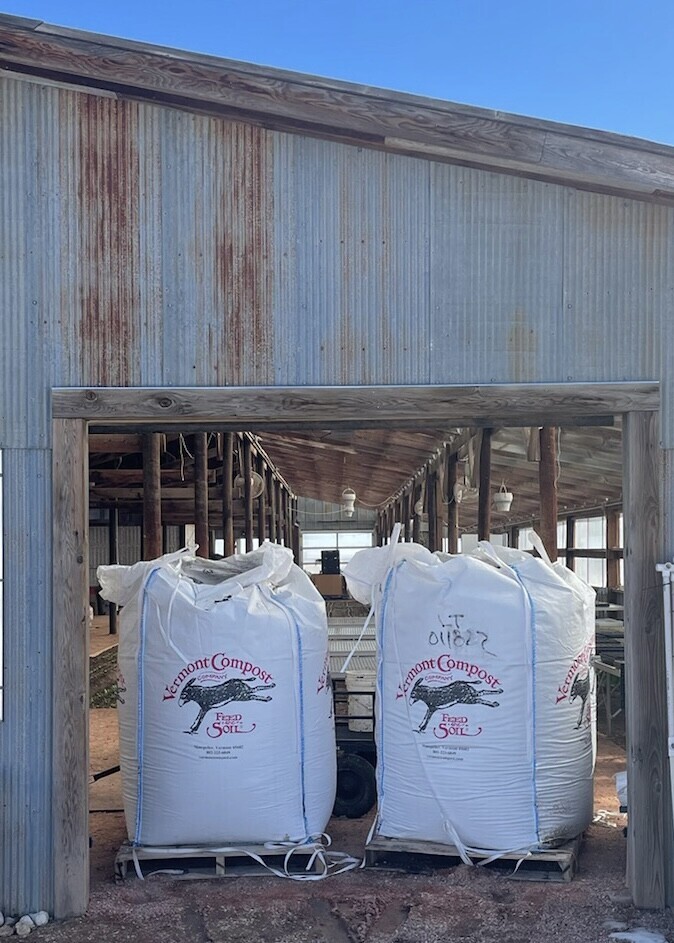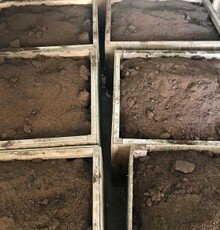
As living material, our soils and composts are resilient, but proper storage helps ensure germination potential and protect against contamination. When choosing where and how to store your bagged soil or compost, consider the following:
Aeration
Reliable nutrient availability is mediated by aerobic microbial activity. To provide adequate aeration, keep soil cool and free of excess moisture, and physically agitate the soil as you remove it from the sling, pile, or bag. This agitation can be as simple as quickly mixing the exposed top of a sling bag’s contents in between rounds of seeding.
Exposure to Light
It’s best to store bagged products out of direct sunlight. The sunlight will degrade the woven polypropylene bags over time, as well as heating and drying out the product. If bags are stored outside, try to place them to the north side of a building, but be sure that they are not under a drip edge.
Temperature
Our soils and composts are a living media. The biota in our products survive freezing temperatures, even for prolonged periods. They become active again when the soil media reaches moderate temperatures. It is perfectly fine for your soil to remain outside (as long as it is protected from precipitation) or in an unheated building throughout the winter. Remember that our soil does take time to defrost; plan on a few days or more for fully frozen sling bags to become workable.
Storing soil in a heated building or greenhouse can cause the soil to dry out over time. While it may be possible to rehydrate the soil and achieve satisfactory results, it’s best to store your soil in a cool environment whenever possible.
Moisture
To help maintain proper moisture, please ensure that bags are adequately protected from sunlight and precipitation while stored outside. If you’re storing bags along the edge of a building, make sure that rain doesn’t drip off the roof and onto the bags, and be sure to tightly tie slings bags while not actively using them. As a result of temperature and exposure to the sun, soil generally retains more moisture over the winter than over the summer.
If soil has dried out slightly, mix wet and dry layers to achieve uniform soil moisture prior to use. If the soil has excessively dried and appears dusty, please water to almost full saturation, and allow it to sit for 24-48 hours so that biological activity can resume.
If you receive soil or compost in bulk (unbagged/delivered by dump truck), managing moisture at the dump site is crucial. To prevent loss, you can have your product unloaded onto a tarp. Please make sure the dump site is well drained so that water will not pool in your soil or compost. We suggest storing bulk soil under cover to prevent nutrient leaching.
Time
Storage time is a function of temperature, exposure to light, moisture retention and other factors. For optimal performance, we generally recommend a maximum storage period of 9 months, depending on these conditions. However, your soil may still perform adequately for up to 12 months.
Before using a soil that has been stored longer than 9 months, we suggest trialing to ascertain germination rates and nutrient availability. Depending on storage conditions, older soil may perform adequately, but trialing is crucial before using older soils for commercial cultivation. Older soil can be added to beds to increase organic matter and fertility.
Preventing Rodents and Other Contaminants

Occasionally, growers will find that rodents have burrowed into their soil and compost piles. While we understand that it’s almost impossible to eliminate all rodents on a farm, rodents can bring unwanted seed into the soil, and we therefore encourage employing best practices for rodent exclusion, including storing soil and seeds in a closed container whenever possible, setting traps, and employing barn cats and dogs.
Likewise, we work hard to provide a product that is free of contaminants. Be conscious about keeping fluids like gasoline, diesel, and oil away from your soil. Also consider road salt contamination while transporting and storing your soil in the winter. We recommend wrapping soil, top and bottom, in a tarp when moving it in an open truck or trailer.
Finally, be sure to clean and sanitize trays and pots between uses. Pests, diseases, and weed seeds can hitch a ride between plantings on leftover soil and other debris. Using clean, sanitized trays ensures that your potting soil will perform at its best.
Some Successful Storage Examples:
- Sling bags stored along the north side of a barn, not under a drip edge, tightly tarped and brought into the greenhouse as needed in the spring
- Pallets of bagged soil stored in a unheated barn or garage, then thawed and warmed before seeding
- Bulk soil kept under a roof or well secured tarp and monitored for rodent activity

Do you have specific questions about storing our products? Email us at info@vermontcompost.com
Thank you to Speedwell Farm and Gardens and Vermont Youth Conservation Corps for their images.
